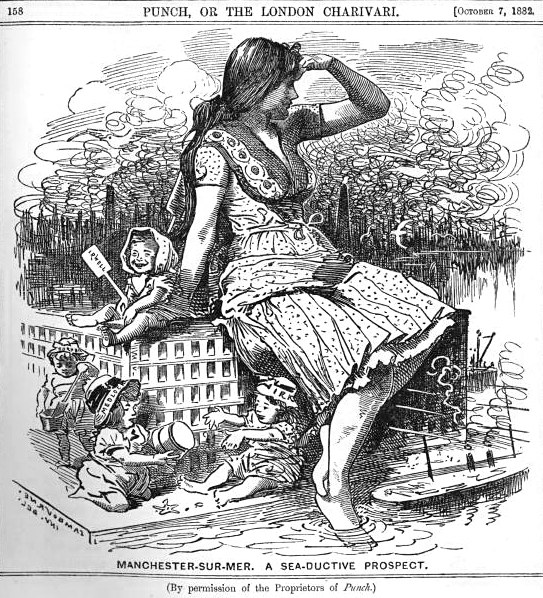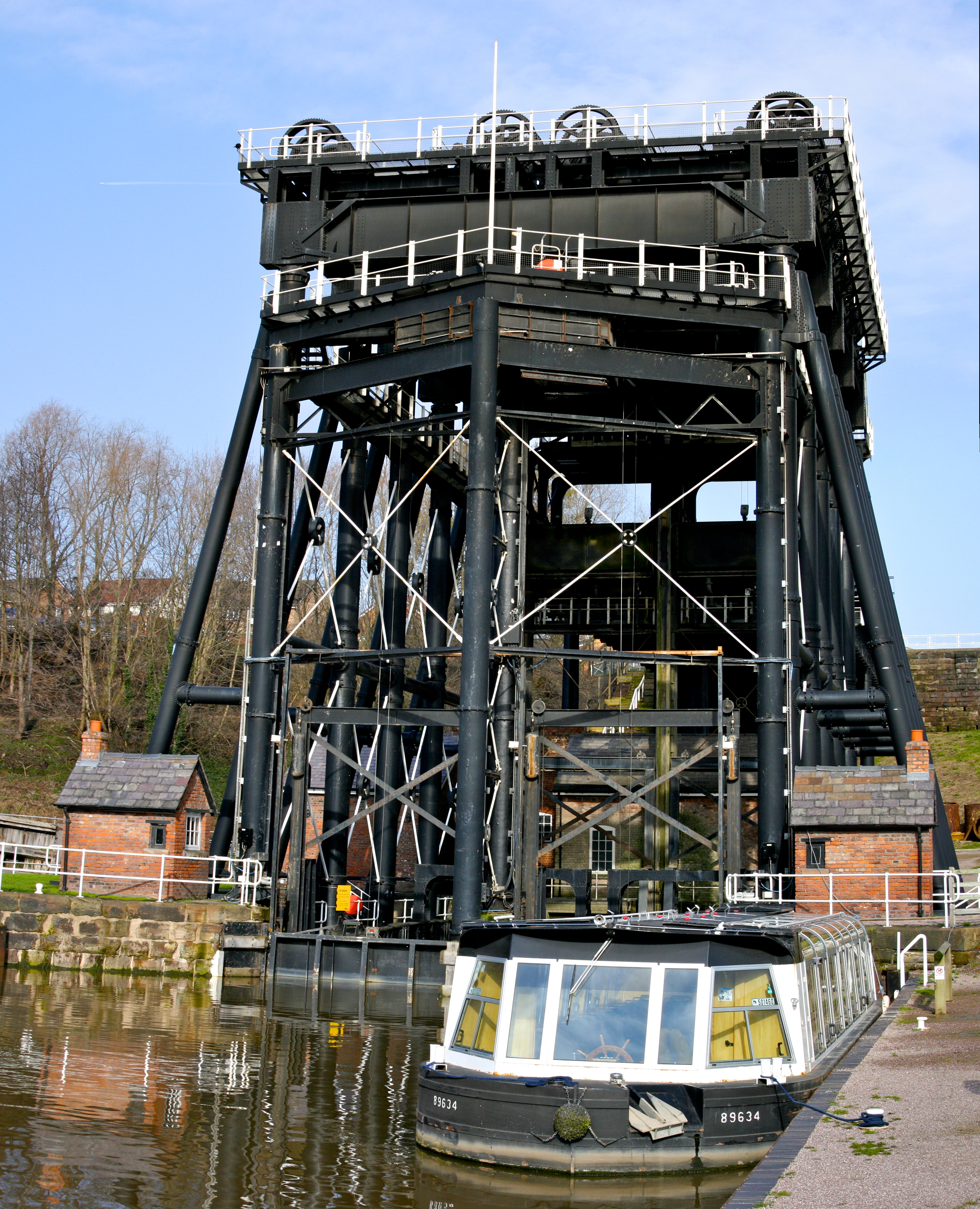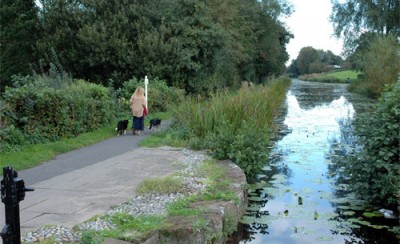|
Middlewich Branch
The Middlewich Branch of the Shropshire Union Canal is located in Cheshire, in the north west of England, and runs between Middlewich, where it joins the Trent and Mersey Canal, and Barbridge Junction, where it joins the main line of the Shropshire Union Canal. It is long, and was planned as part of the Chester Canal, which was authorised in 1772, but the company ran out of money, and construction did not begin until 1827. The Trent and Mersey insisted that there should be no direct connection at Middlewich, and instead built the short Wardle Canal to join the two, charging large compensation tolls for traffic passing along it. The canal became part of the Shropshire Union system in 1846, which was taken over by the London and North Western Railway within a year. Traffic on the branch was always limited by the compensation tolls, and it was not until 1888 that they were abolished. The canal was the location for trials with locomotive haulage of boats in 1888, using a narrow-gaug ... [...More Info...] [...Related Items...] OR: [Wikipedia] [Google] [Baidu] |
Middlewich
Middlewich is a town in the unitary authority of Cheshire East and the ceremonial county of Cheshire, England, east of Chester, east of Winsford, southeast of Northwich and northwest of Sandbach. The population at the 2011 Census was 13,595. Middlewich lies at the confluence of three rivers, the Dane, Croco and Wheelock. Three canals also pass through the town, the Shropshire Union, Trent and Mersey, and the Wardle Canal, as well as three major roads, the A533, A54 and A530; Middlewich also has good motorway links to the nearby cities of Manchester and Liverpool. The town's population has doubled since 1970 despite a reduction in the number of manufacturing jobs in salt and textile manufacturing, suggesting that many of the new residents live in Middlewich for reasons other than local employment. Since 1990 there have been initiatives to increase the volume of tourism into the town, through events such as the annual folk and boat festival, the Roman and Norman festiv ... [...More Info...] [...Related Items...] OR: [Wikipedia] [Google] [Baidu] |
Ellesmere Canal
The Ellesmere Canal was a waterway in England and Wales that was planned to carry boat traffic between the rivers Mersey and Severn. The proposal would create a link between the Port of Liverpool and the mineral industries in north east Wales and the manufacturing centres in the West Midlands. However, the canal was never completed as intended because of its rising costs and failure to generate the expected commercial traffic. The Ellesmere Canal, which was first proposed in 1791, would have created a waterway between Netherpool, Cheshire, and Shrewsbury. However, only certain sections were completed; these were eventually incorporated into the Chester Canal, Montgomery Canal and Shropshire Union Canal. Although several major civil engineering feats were accomplished, major building work ceased following the completion of the Pontcysyllte Aqueduct in 1805. The northern end of the navigation's mainline ended from Chester at Trevor Basin near Ruabon and its southern end was at We ... [...More Info...] [...Related Items...] OR: [Wikipedia] [Google] [Baidu] |
Accommodation Bridge
In the United Kingdom, an accommodation bridge or occupation bridge is one that preserves a pre-existing private road, path or right-of-way (transportation), right of access when a major transport route is built across it. Without the bridge, access would be disrupted. Accommodation bridges are usually built at the cost of the route developer, as part of the conditions for obtaining the land for building the new route. The term is not applied where the new route crosses an existing public highway. Canals The first accommodation bridges were built as part of 18th-century canal building. Most were provided for farmers, whose lands and grazing were separated by the canal. The first canals developed from rivers, with short lengths of canal built to bypass obstacles, such as weirs and millponds. The river represented a long-established and accepted boundary, but these new sections were resented by landlords. Unlike turnpike trusts, turnpike roads, droving, drovers could not simply c ... [...More Info...] [...Related Items...] OR: [Wikipedia] [Google] [Baidu] |
Church Minshull
Church Minshull is a village and civil parish in the unitary authority of Cheshire East and the ceremonial county of Cheshire, England. The village is approximately north west of Crewe, just west of the River Weaver and Shropshire Union Canal. The principal road through Church Minshull is the B5074 between Nantwich (6 miles to the south) and Winsford (4 miles to the north). The modern village centre is a designated conservation area which contains many houses of Tudor style architecture. A large area in the east of the parish falls within the Weaver Valley Area of Special County Value. The population at the 2001 Census was 431, living in 196 residences of which sixty are on Home Farm Park and twenty on Village Farm. The parish is made up of . The population at the 2011 Census had reduced slightly to 426. History The name of the village is recorded in the ''Domesday Book'' as ''Maneshale''. According to records from November 1824, numerous trades and crafts were carried out in ... [...More Info...] [...Related Items...] OR: [Wikipedia] [Google] [Baidu] |
West Coast Main Line
The West Coast Main Line (WCML) is one of the most important railway corridors in the United Kingdom, connecting the major cities of London and Glasgow with branches to Birmingham, Liverpool, Manchester and Edinburgh. It is one of the busiest mixed-traffic railway routes in Europe, carrying a mixture of intercity rail, regional rail, commuter rail and rail freight traffic. The core route of the WCML runs from London to Glasgow for and was opened from 1837 to 1869. With additional lines deviating to Northampton, Birmingham, Manchester, Liverpool and Edinburgh, this totals a route mileage of . The Glasgow–Edinburgh via Carstairs line connects the WCML to Edinburgh, however the main London–Edinburgh route is the East Coast Main Line. Several sections of the WCML form part of the suburban railway systems in London, Coventry, Birmingham, Liverpool, Manchester and Glasgow, with many more smaller commuter stations, as well as providing links to more rural towns. It is one of the ... [...More Info...] [...Related Items...] OR: [Wikipedia] [Google] [Baidu] |
River Wheelock
The River Wheelock is a small river in Cheshire in north west England. It drains water from the area between Sandbach and Crewe, and joins the River Dane at Middlewich (), and then the combined river flows into the River Weaver in Northwich. Alternative names for the river have were recorded in 1619 as ''Sutton Watter'', ''Sutton Brooke'', and ''Lawton Brooke''. Early recorded variations of the name Wheelock have included ''Quelok'', ''Qwelok'', ''Whelok'', ''Whelocke'', with later forms using ''Wheelock Watter'' and ''Wheelock Brooke''. The name is said to mean "winding river" and it is reported to have based on the Old Welsh word ''chwylog'', the ''chwyl'' part of which means "a turn, a rotation, a course", with an adjective suffix of ''og''. The river has given its name to the large village of Wheelock. Origin In his book ''The History of Cheshire'' (1778), Daniel King ''et al'' write: :"The Wheelock is also engendered of three small rivers, which spring not far from Mowcop ... [...More Info...] [...Related Items...] OR: [Wikipedia] [Google] [Baidu] |
Manchester Ship Canal
The Manchester Ship Canal is a inland waterway in the North West of England linking Manchester to the Irish Sea. Starting at the Mersey Estuary at Eastham, near Ellesmere Port, Cheshire, it generally follows the original routes of the rivers Mersey and Irwell through the historic counties of Cheshire and Lancashire. Several sets of locks lift vessels about to the canal's terminus in Manchester. Landmarks along its route include the Barton Swing Aqueduct, the world's only swing aqueduct, and Trafford Park, the world's first planned industrial estate and still the largest in Europe. The rivers Mersey and Irwell were first made navigable in the early 18th century. Goods were also transported on the Runcorn extension of the Bridgewater Canal (from 1776) and the Liverpool and Manchester Railway (from 1830), but by the late 19th century the Mersey and Irwell Navigation had fallen into disrepair and was often unusable. In addition, Manchester's business community viewed the cha ... [...More Info...] [...Related Items...] OR: [Wikipedia] [Google] [Baidu] |
River Weaver
The River Weaver is a river, navigable in its lower reaches, running in a curving route anti-clockwise across west Cheshire, northern England. Improvements to the river to make it navigable were authorised in 1720 and the work, which included eleven locks, was completed in 1732. An unusual clause in the enabling Act of Parliament stipulated that profits should be given to the County of Cheshire for the improvement of roads and bridges, but the navigation was not initially profitable, and it was 1775 before the first payments were made. Trade continued to rise, and by 1845, over £500,000 had been given to the county. The major trade was salt. The arrival of the Trent and Mersey Canal at Anderton in 1773 was detrimental to the salt trade at first, but ultimately beneficial, as salt was tipped down chutes from the canal into barges on the river navigation. Access to the river was improved in 1810 by the Weston Canal, which provided a link to Weston Point, where boats could reach ... [...More Info...] [...Related Items...] OR: [Wikipedia] [Google] [Baidu] |
Anderton Lift
The Anderton Boat Lift is a two caisson lift lock near the village of Anderton, Cheshire, in North West England. It provides a vertical link between two navigable waterways: the River Weaver and the Trent and Mersey Canal. The structure is designated as a scheduled monument, and is included in the National Heritage List for England; it is also known as one of the Seven Wonders of the Waterways. Built in 1875, the boat lift was in use for over 100 years until it was closed in 1983 due to corrosion. Restoration started in 2001 and the boat lift was re-opened in 2002. The lift and associated visitor centre and exhibition are operated by the Canal & River Trust. It is one of only two working boat lifts in the United Kingdom; the other is the Falkirk Wheel in Scotland. Economic background Salt has been extracted from rock salt beds underneath the Cheshire Plain since Roman times. By the end of the 17th century a major salt mining industry had developed around the Cheshire "salt t ... [...More Info...] [...Related Items...] OR: [Wikipedia] [Google] [Baidu] |
House Of Lords
The House of Lords, also known as the House of Peers, is the Bicameralism, upper house of the Parliament of the United Kingdom. Membership is by Life peer, appointment, Hereditary peer, heredity or Lords Spiritual, official function. Like the House of Commons of the United Kingdom, House of Commons, it meets in the Palace of Westminster in London, England. The House of Lords scrutinises Bill (law), bills that have been approved by the House of Commons. It regularly reviews and amends bills from the Commons. While it is unable to prevent bills passing into law, except in certain limited circumstances, it can delay bills and force the Commons to reconsider their decisions. In this capacity, the House of Lords acts as a check on the more powerful House of Commons that is independent of the electoral process. While members of the Lords may also take on roles as government ministers, high-ranking officials such as cabinet ministers are usually drawn from the Commons. The House of Lo ... [...More Info...] [...Related Items...] OR: [Wikipedia] [Google] [Baidu] |
Shropshire Canal
The Shropshire Canal was a tub boat canal built to supply coal, ore and limestone to the industrial region of east Shropshire, England, that adjoined the River Severn at Coalbrookdale. It ran from a junction with the Donnington Wood Canal ascending the 316 yard long Wrockwardine Wood inclined plane to its summit level, it made a junction with the older Ketley Canal and at Southall Bank the Coalbrookdale (Horsehay) branch went to Brierly Hill above Coalbrookdale; the main line descended via the 600 yard long Windmill Incline and the 350 yard long Hay Inclined Plane to Coalport on the River Severn. The short section of the Shropshire Canal from the base of the Hay Inclined Plane to its junction with the River Severn is sometimes referred to as the Coalport Canal. Construction of the canal was completed in 1792, and it operated successfully until the 1830s. The construction and operation of the Hay inclined plane was documented by two Prussian engineers who visited it in 1826 or 18 ... [...More Info...] [...Related Items...] OR: [Wikipedia] [Google] [Baidu] |
Shrewsbury Canal
The Shrewsbury Canal (or Shrewsbury and Newport Canal) was a canal in Shropshire, England. Authorised in 1793, the main line from Trench to Shrewsbury was fully open by 1797, but it remained isolated from the rest of the canal network until 1835, when the Birmingham and Liverpool Junction Canal built the Newport Branch from Norbury Junction to a new junction with the Shrewsbury Canal at Wappenshall. After ownership passed to a series of railway companies, the canal was officially abandoned in 1944; many sections have disappeared, though some bridges and other structures can still be found. There is an active campaign to preserve the remnants of the canal and to restore the Norbury to Shrewsbury line to navigation. History From 1768 several small canals were built in the area of what is now Telford. These canals carried tub boats. The first of these was the Donnington Wood Canal which opened in 1768, to be followed by the Wombridge Canal and the Ketley Canal, both opened in 178 ... [...More Info...] [...Related Items...] OR: [Wikipedia] [Google] [Baidu] |
.jpg)









